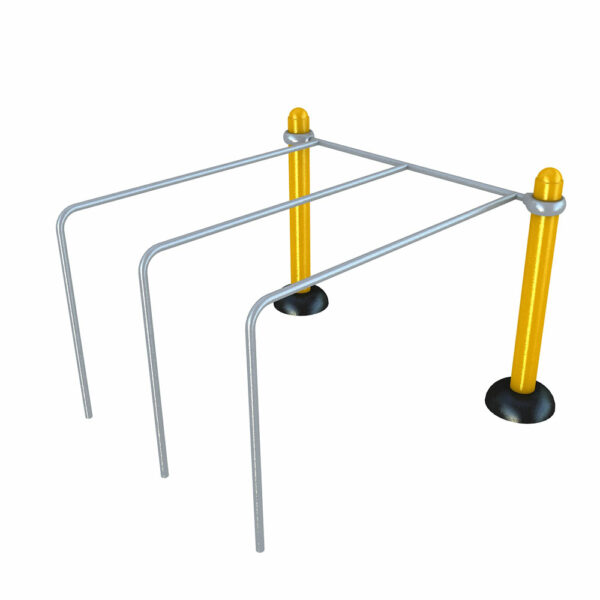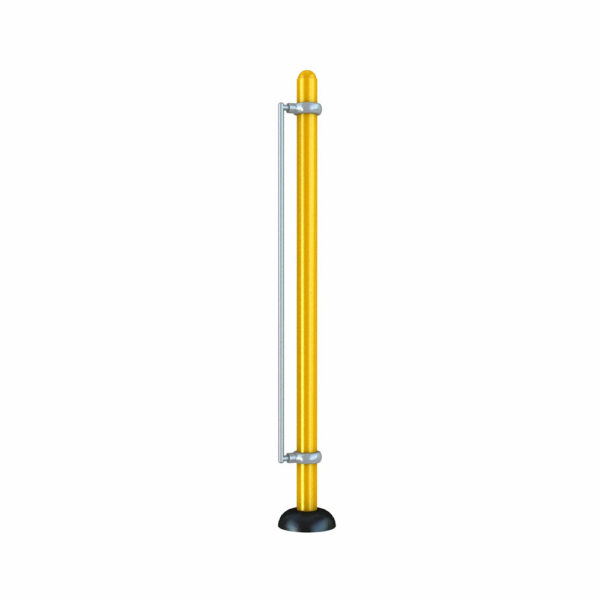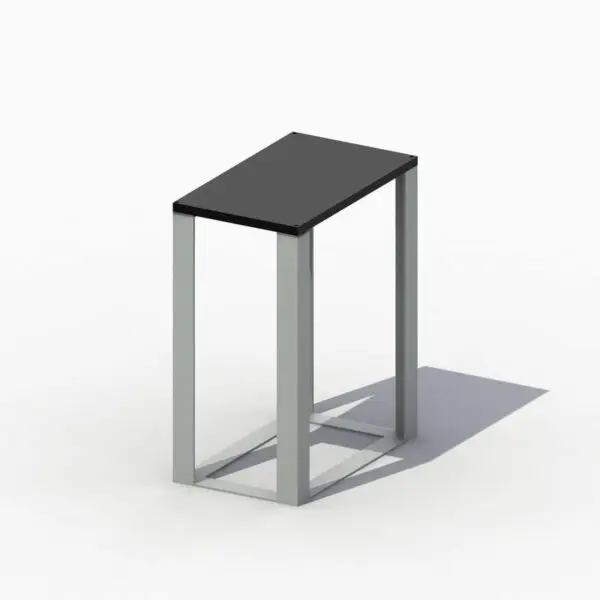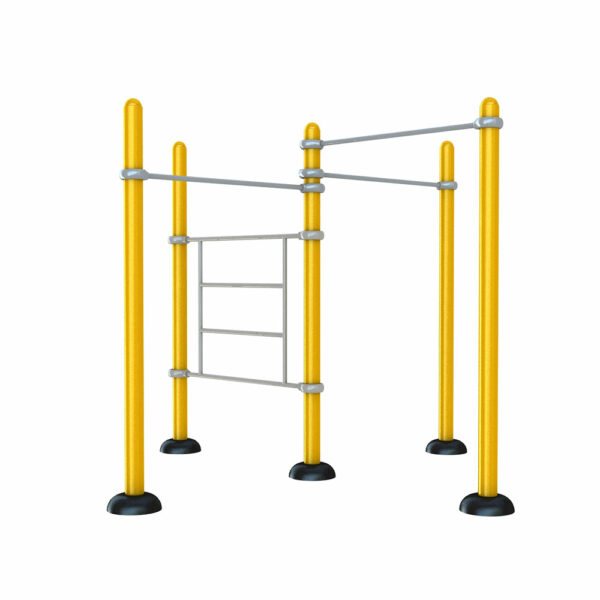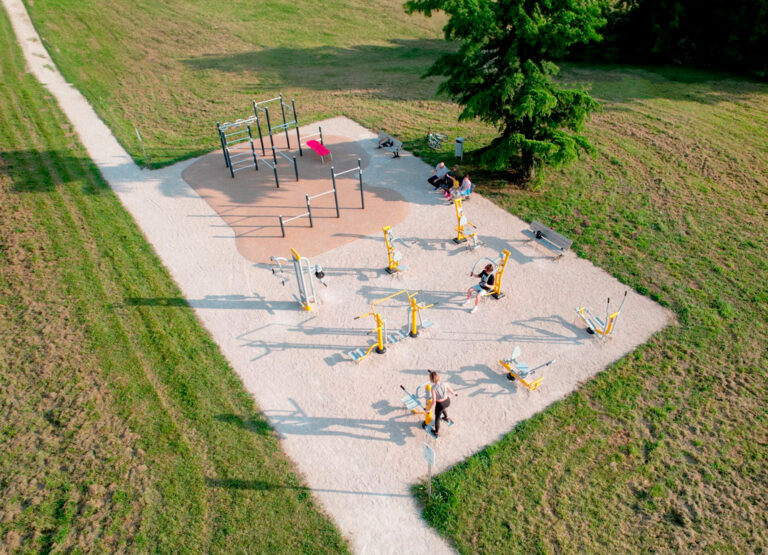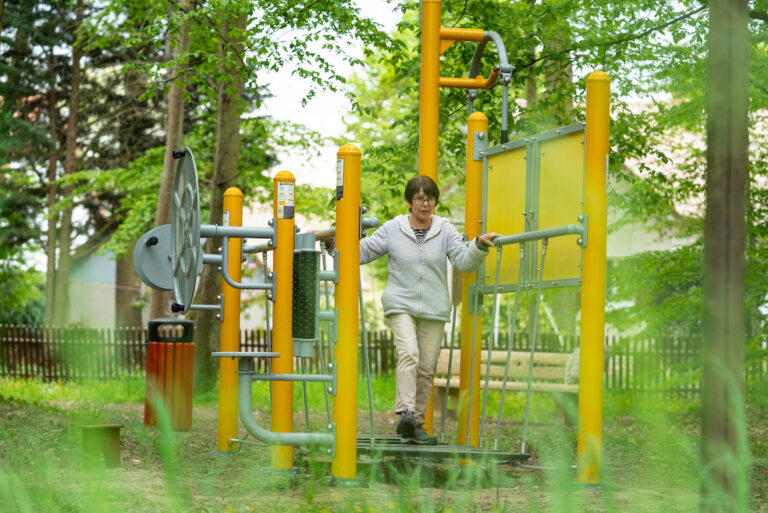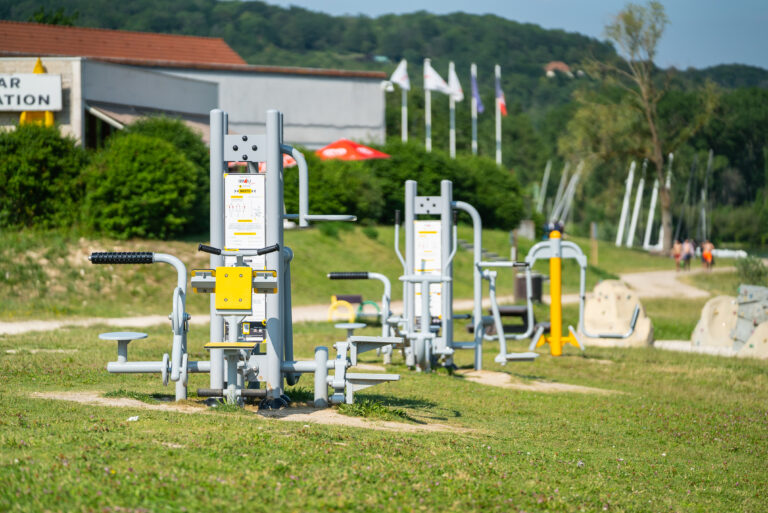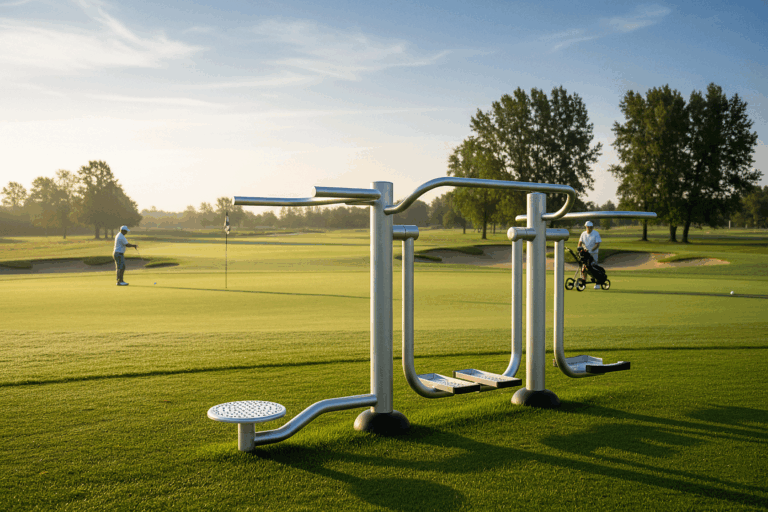Street workout, the new star of urban sports
For several years now, street workout has been one of the most popular disciplines in public spaces. Born in the streets of New York and popularized by urban culture, this sport combining strength, agility and creativity has conquered the parks and squares of many cities around the world.
In France, the street workout craze has gathered pace with changing lifestyles. Faced with a growing sedentary lifestyle, local authorities and companies are increasingly investing in sports facilities that are accessible to all, open-air and free of charge. Street workout areas have become popular meeting places not only for seasoned athletes, but also for novices, families and senior citizens.
Post-Covid, outdoor training is booming: the need for fresh air, the search for alternatives to closed gyms, the desire to reclaim urban space. This trend has reinforced the importance of installing street workout areas or outdoor fitness areas to meet user expectations and energize public and private spaces.
In this comprehensive guide, find out everything you need to know to design and build a high-performance, sustainable street workout area tailored to the needs of your community or employees.
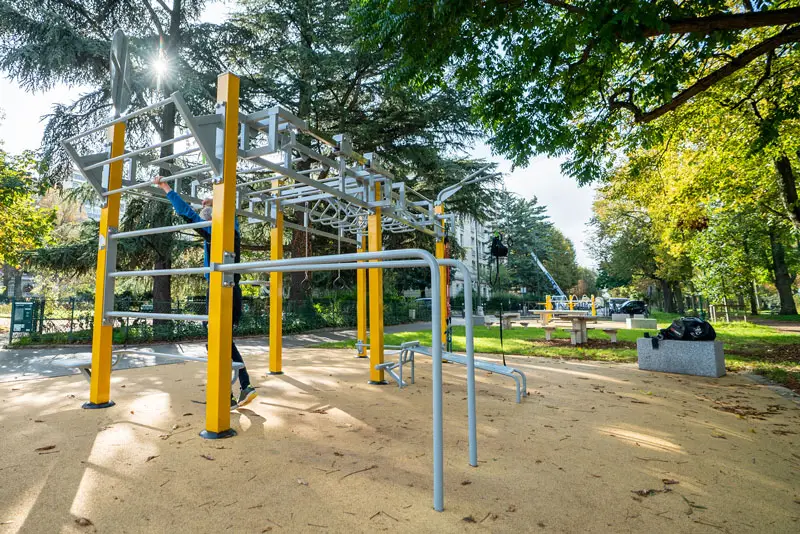
What is a street workout area?
A clear definition
A street workout area is an outdoor space specially designed for bodyweight exercises. Inspired by gymnastics equipment and calisthenics methods, it allows you to perform a variety of functional movements: pull-ups, dips, push-ups, sheathing and much more.
Unlike a simple playground or a traditional fitness trail, the street workout area is designed to meet the needs of athletes of all levels. Its main advantage? Total freedom of movement thanks to versatile modules accessible 24/7.
Street workout vs. outdoor fitness area: what’s the difference?
Often confused, the terms street workout area and outdoor fitness area refer to two slightly different concepts:
- An outdoor fitness area generally incorporates guided or semi-guided machines(rowing machine, outdoor elliptical, weight benches) designed to reproduce the experience of an outdoor gym. This equipment is mainly aimed at a general public of all ages.
- Thestreet workout area, on the other hand, is more focused on free bodyweight training. Here, you’ll find fixed bars, parallel bars, espaliers and modules for complex figures and exercises, typical of calisthenics.
In short, the street workout area encourages creativity and the development of overall physical skills (strength, balance, mobility), while an outdoor fitness area can be seen as more accessible to beginners looking for a guided setting.
A discipline rooted in urban culture
Street workout is much more than just a physical workout: it’s a genuine cultural movement. Rooted in urban culture, it embodies strong values such as mutual aid, inclusiveness and resilience.
In many towns and cities, these areas are becoming meeting points for a wide variety of enthusiasts: young sportsmen and women, gymnastics enthusiasts, fitness enthusiasts, but also club members and parkour and freerun enthusiasts.
This sport, which emphasizes the simplicity of the equipment and the use of street furniture, fits in perfectly with current trends in the redevelopment of public spaces and the promotion of outdoor health.
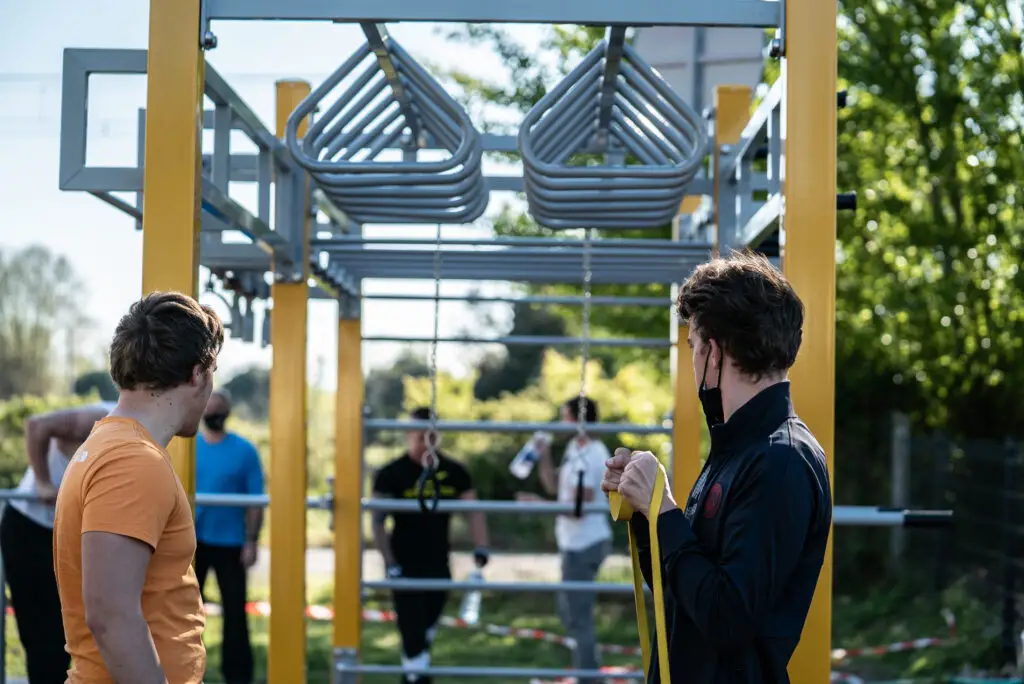
Why install a street workout area?
A lever for public health
Installing a street workout area is first and foremost a public health issue. Faced with an increasingly sedentary lifestyle and a lack of physical activity among the population, offering a free training area is a way of encouraging people to take up sport on a regular basis.
These outdoor facilities encourage physical activity for all ages, including those who are far removed from traditional gyms. In both urban and rural environments, they help combat inactivity, reducing the risk of cardiovascular disease, obesity and musculoskeletal disorders.
Studies have shown that outdoor exercise has significant advantages over indoor exercise. For example, a study carried out in 2019 revealed that 20 minutes spent in contact with nature is enough to reduce the level of cortisol, the stress hormone, in our bodies.sportsdenature.gouv.fr
An asset for revitalizing urban spaces
Street workout areas transform spaces that are often under-used – squares, parks, lakeshores or urban wastelands – into real places of life and appeal. These sports facilities create links between local residents and enhance the value of little-used areas.
They contribute to the liveliness of neighborhoods and can be integrated into a more global strategy of active urban planning and sustainable development. By redeveloping spaces for the free practice of sport, local authorities can modernize the image of their territory and contribute to a more pleasant living environment.
Some cities go even further, creating real street workout parks integrated into landscaped and cultural projects: skateparks, pumptracks, parkour zones and health trails.
A tool for strengthening social cohesion
The street workout area is also a place for social and intergenerational mixing. Open to all, it brings together seasoned athletes and novices alike, young and old alike.
These spaces become meeting places where exercisers help each other, exchange advice and create a real community. In some neighborhoods, they contribute to social inclusion by making physical activity accessible even to people on modest incomes.
The events organized around these areas – street workout competitions, free initiations, supervised workshops – further reinforce this collective dynamic.
A CSR lever for companies
For companies and business parks, the installation of a street workout or outdoor fitness area is an integral part of a quality of working life (QWL) and corporate social responsibility (CSR) approach.
Encouraging physical activity in the workplace helps to improve employee health, reduce absenteeism and strengthen team cohesion. By creating an outdoor sports area accessible to employees, companies can create an environment conducive to well-being and performance.
Key steps for designing and installing a street workout area
Before you get started, remember these 3 essential steps:
1️⃣ Analyze the site and needs: assess the available surface area, user profile and site constraints.
2️⃣ Choose suitable equipment: comply with safety standards and select durable, inclusive modules.
3️⃣ Install and secure the area: take care with the layout (shock-absorbing surfacing, safety distances) and plan maintenance.
Step 1: Analyze the site and your needs
First and foremost, the design of a street workout area requires an in-depth analysis. Each project is unique and must meet the specific expectations of future users, as well as the constraints of the environment.
Identify target audience
- Local community: the public is often very heterogeneous (young adults, active seniors, families, experienced athletes). We therefore need to design a multi-purpose area with equipment adapted to all levels.
- Company or private space: in this case, equipment can be designed according to the profile of employees or residents (executives, employees, occasional sportsmen and women).
This stage determines the type of modules to be installed, the number of stations required and the preferred level of difficulty.
Study the environment and available surface area
- What surface area can be used? A street workout area can be adapted to spaces of varying sizes, from 50 m² to over 300 m².
- Is the site in a dense urban environment, in a suburban area or in the middle of nowhere? This influences the design, materials and overall layout.
- Are there any technical constraints (proximity to dwellings, PMR accessibility, type of soil)?
The site analysis also takes into account aspects such as exposure (shade, sun), landscape integration and the possibility of enlarging the area in the future.
Step 2: Choosing the right equipment
A successful street workout area relies on a judicious choice of modules that comply with safety standards and are suitable for all kinds of users.
Compliance with standards and certifications
In France and Europe, equipment must meet specific requirements to guarantee user safety:
- Standard EN16630 for fixed outdoor physical activity equipment.
- PMR (persons with reduced mobility) accessibility for certain modules and circulation in the area.
- Clear signage: sign with instructions for use and safety recommendations.
Choose sustainable materials
The choice of materials is crucial to guarantee longevity and weather resistance:
- Galvanized or stainless steel: corrosion-resistant, ideal for coastal or exposed areas.
- Non-slip coatings on contact or support areas.
Design and aesthetics can also be adapted to the DNA of the location: a sleek urban look for a city center, a more natural style for a wooded park, or a dynamic sports approach for a campus.
Step 3: Installation and safety
Space planning
The layout of the equipment must allow fluid circulation between the various stations, while respecting safety distances.
- Minimum distance between each module to avoid the risk of collision.
- Creating an open space easily accessible to all.
- Visibility and passive safety (avoiding blind spots).
Suitable coverings
The choice of soil is essential for safe practice:
- Cushioning surface: flexible floor (EPDM type), wood chips, stabilized sand or synthetic turf, depending on site constraints.
- The flooring is chosen according to the equipment’s drop height , a fundamental criterion for guaranteeing user safety.
👉 Want to know more? We’ve written a comprehensive article on the subject of fall heights and surfaces suitable for street workout areas. [Read it here]
Essential equipment for a complete workout
Essential modules
To offer a rich street workout experience adapted to all users, certain equipment is essential in the design of an area. These basic modules enable you to work the whole body through a variety of exercises.
Drawbars
Pull-up bars are the central element of any street workout area. They enable you to perform classic pull-ups, as well as variations such as Australian pull-ups, muscle-ups and pronated and supinated pull-ups. Available in different heights, they are suitable for beginners and experienced athletes alike.
Parallel bars
Essential for working triceps, pectorals and shoulders, parallel bars can be used for dips, L-sits, planks and other isometric movements. They are also used for handstand training and core-strengthening exercises.
Espaliers
Espaliers are versatile vertical structures for suspension exercises, ab crunches and calisthenics such as the human flag. These modules are also ideal for stretching and warming up joints.
Advanced equipment for experienced athletes
To attract the most experienced practitioners, it’s a good idea to integrate more technical modules adapted to calisthenics or disciplines such as parkour.
Multifunction stations
Some structures combine several modules in a single installation: pull-up bars at different heights, inclined bars for lower-body work, and low bars for push-ups or dips. These stations maximize the use of available space.
Modules for advanced figures
- Muscle-up bars with sufficient clearance.
- Inclined bars for back and front levers.
- Specific modules for learning human flag, planks or static and dynamic figures.
Accessibility and inclusiveness
A well-designed street workout area must be inclusive. Integrating equipment adapted for people with reduced mobility enables access for all, without discrimination.
Modules adapted for PMR
- Wheelchair-accessible low pull stations.
- Modules for strengthening the upper body in a seated position.
- Stabilized floors to ensure smooth circulation within the area.
Local authorities and businesses alike are increasingly attentive to this universal accessibility criterion, which enhances the attractiveness and social impact of infrastructures.
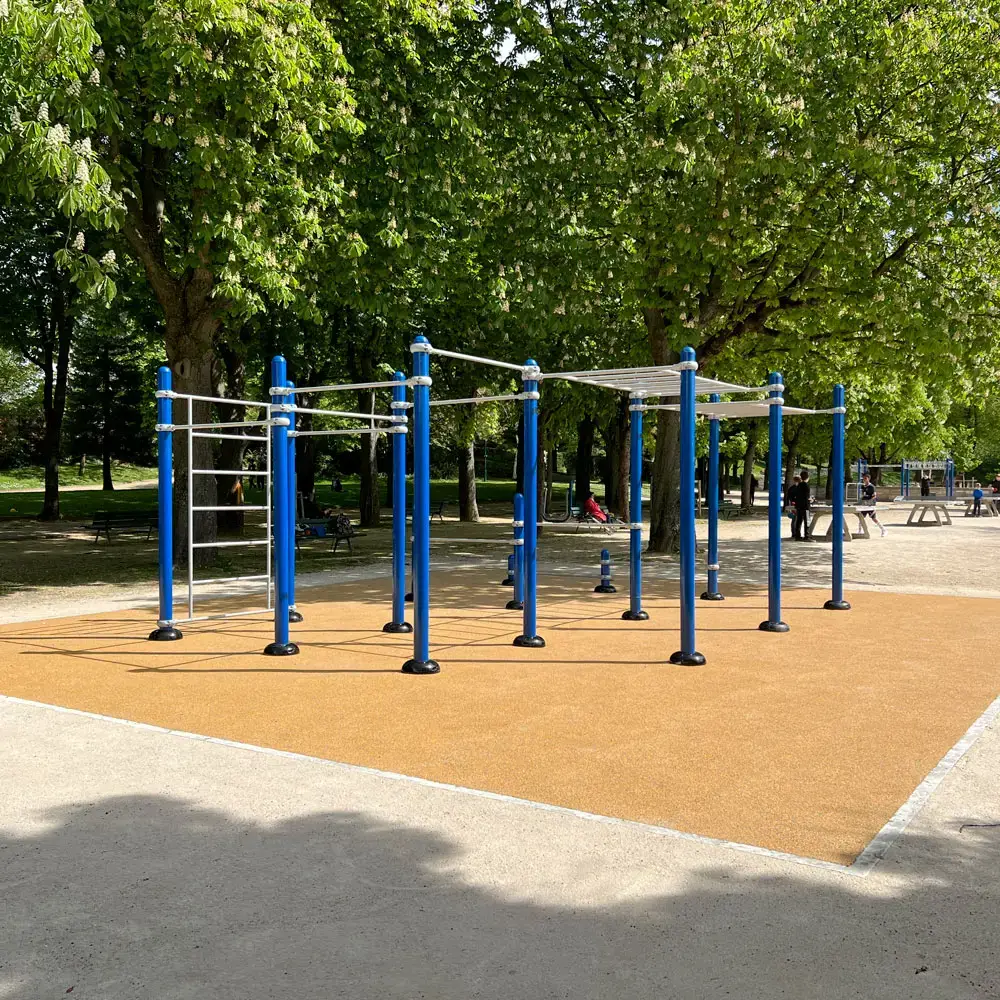
Street workout & calisthenics: complementary practices
Street workout or calisthenics: what’s the difference?
Although often confused, street workout and calisthenics refer to two slightly different approaches to the same philosophy: bodyweight training.
- Calisthenics is a training method based exclusively on bodyweight exercises. This discipline focuses on fundamental movements such as pull-ups, dips, push-ups and squats, with the aim of building overall muscle strength. It is sometimes practised indoors or indoors.
- Street workout is the urban, outdoor version of calisthenics. It incorporates not only classic bodyweight exercises, but also spectacular acrobatic figures and impressive static movements (human flag, front lever, muscle-up, plank…). Street workout is strongly associated with urban park culture and group training.
The two disciplines are therefore complementary: calisthenics lays the foundations for strength and body control, while street workout pushes these skills towards dynamic, creative performances.
Examples of typical circuits for different levels
Whether you’re a beginner or an advanced exerciser, a well-equipped street workout area allows you to create varied and effective routines. Here are a few examples of circuits adapted to different levels.
Beginner level
- Classic push-ups (3 sets of 10 to 15 repetitions)
- Dips on low bar or bench (3 sets of 8 to 12)
- Bodyweight squats (3 sets of 15)
- Passive barbell suspension (3 sets of 20 seconds)
- Floor gainage (3 x 30 seconds)
Intermediate level
- Pronation pull-ups (3 sets of 6 to 10)
- Dips on parallel bars (3 sets of 8 to 12)
- Jump squats (3 sets of 12)
- L-sit on parallel bars (3 x 15 seconds)
- Front support (arms outstretched) on pull-up bar (3 x 20 seconds)
Advanced level
- Muscle-up (3 sets of 3 to 5)
- Front lever hold (3 x 10 to 15 seconds)
- Human flag (attempts or maintenance depending on level)
- Weighted dips (3 sets of 8 to 10)
- Superset explosive pull + explosive dips (4 sets)
Impact on health and physical performance
Street workout is one of the most complete workouts for developing various physical qualities:
- Functional strength: improved relative strength (ability to move one’s own body).
- Mobility and flexibility: many exercises require good joint control.
- Coordination and balance: essential for advanced figures and transitions.
- General fitness: regular outdoor training also strengthens cardio-respiratory capacity and muscle tone.
As an added bonus, exercising outdoors exposes the body to natural light, promotes the secretion of endorphins and improves morale.
Case studies: concrete projects
Communities: the street workout area as a lever of attractiveness
Direction Paris 11th, where the Square des Jardiniers has recently been transformed into a modern sports area with the creation of a street workout area designed by Herkules Fitness. Nestled in the heart of this lively, dynamic neighborhood, the new facility is designed to meet the growing demand among residents for accessible outdoor sports facilities.
The aim of this project was clear:
- Offer a multi-purpose street workout area to meet the needs of all levels of users.
- Create a space forfree physical activity in the heart of the city.
- Promote social cohesion and dynamism in the neighborhood by creating a convivial space open to all.
An installation designed for all levels
The Square des Jardiniers is built around a set of facilities adapted to the evolving practice of street workout and calisthenics:
- Multi-height drawbars,
- Parallel bars for dips and L-sit,
- Dedicated areas for Australian pull-ups and basic exercises for beginners.
The configuration of the modules and the use of safe shock-absorbing surfacing ensure both user safety and an optimal experience for all levels, from amateur to seasoned athlete.
A project co-conceived with the French Street Workout Federation
To guarantee the quality and relevance of the equipment, this project was designed in partnership with the French Street Workout Federation. This collaboration made it possible to integrate the expectations of practitioners and to respect the technical and pedagogical standards of the discipline.
Thanks to this co-design, the Square des Jardiniers area has become a model of design combining technicality, inclusiveness and accessibility for all street workout enthusiasts.
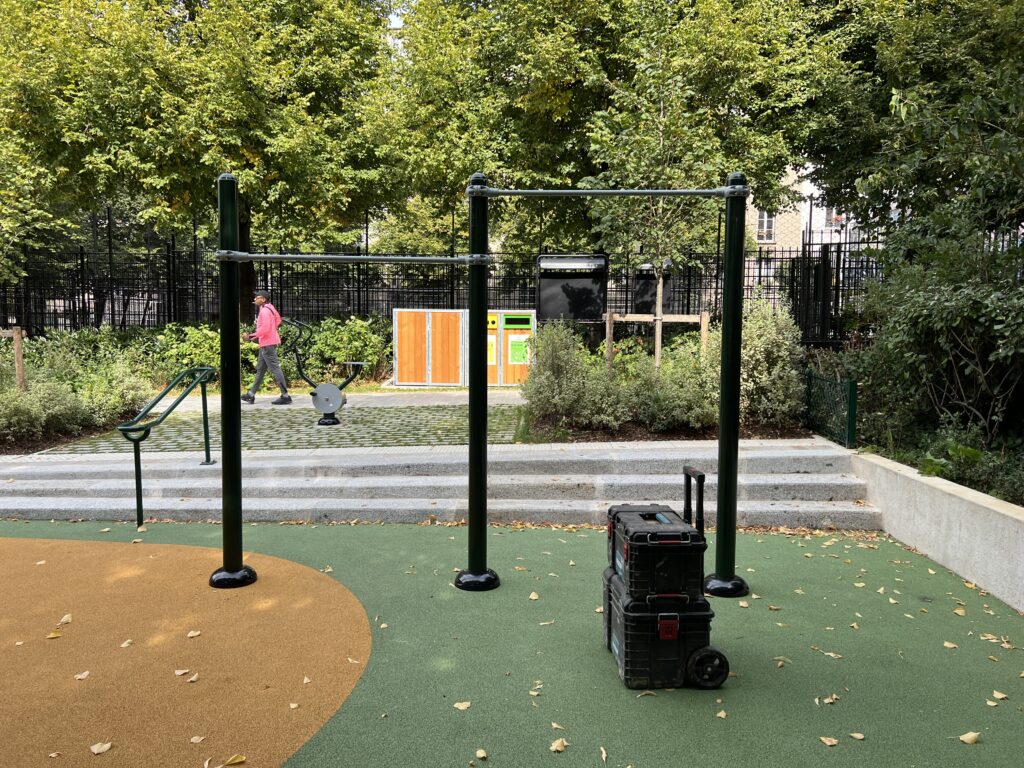
Make street workout a lever for your urban or private space
Today, street workout is a mainstay of modern urban sports. By installing a street workout area, you can promote public health, create spaces for socializing and breathe new life into your outdoor spaces, whether public or private.
Local authorities, companies and urban space managers who integrate this type of infrastructure quickly see a positive return: an improved living environment, a stronger social fabric and an enhanced image with users or employees.
At Herkules Fitness, we support cities, companies and developers in the design and installation of tailor-made street workout areas, adapted to each environment and need.
👉 Do you have a project in mind? Whether you’re planning an urban park, revitalizing a neighborhood or offering your teams an outdoor wellness area, our teams are here to advise you.
Ask now for your personalized study and get a free quote via our contact form.
📩 Contact us here : [Herkules contact]
Join the outdoor sports movement and offer your users a modern, sustainable training space!

